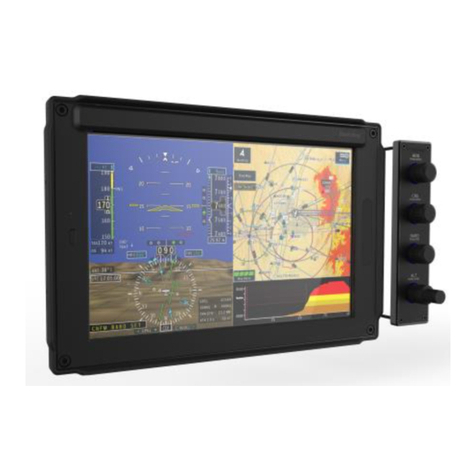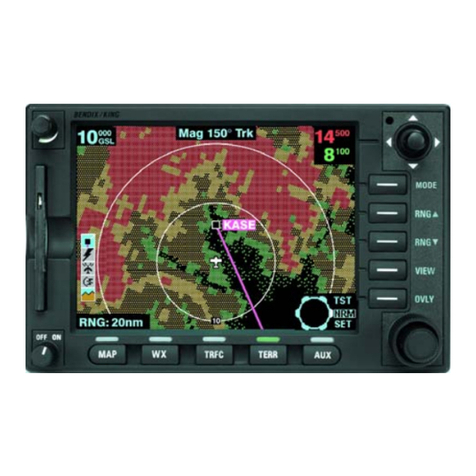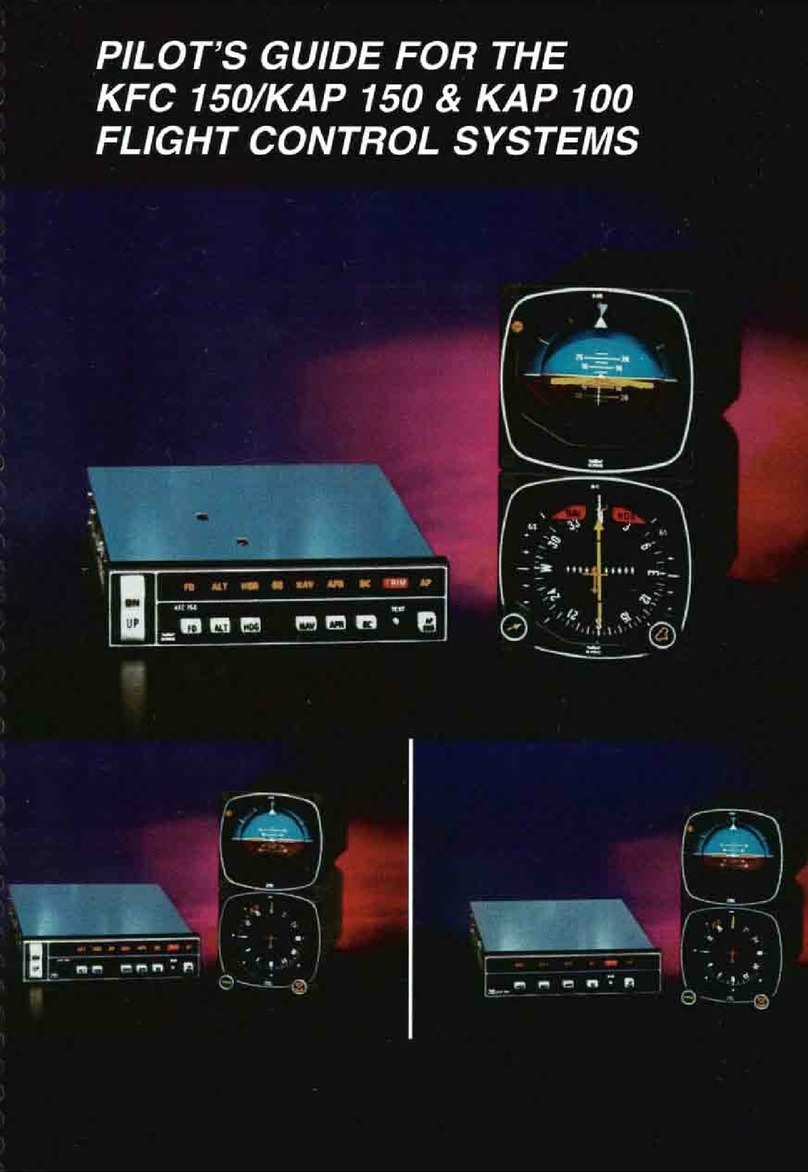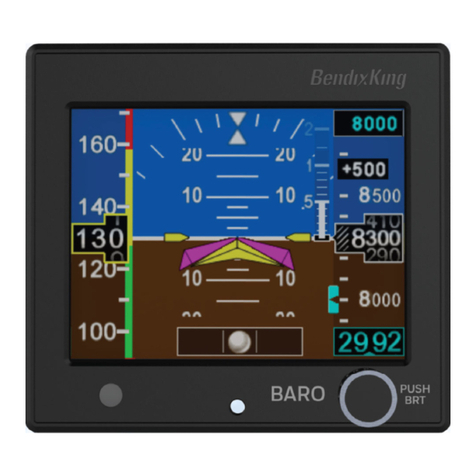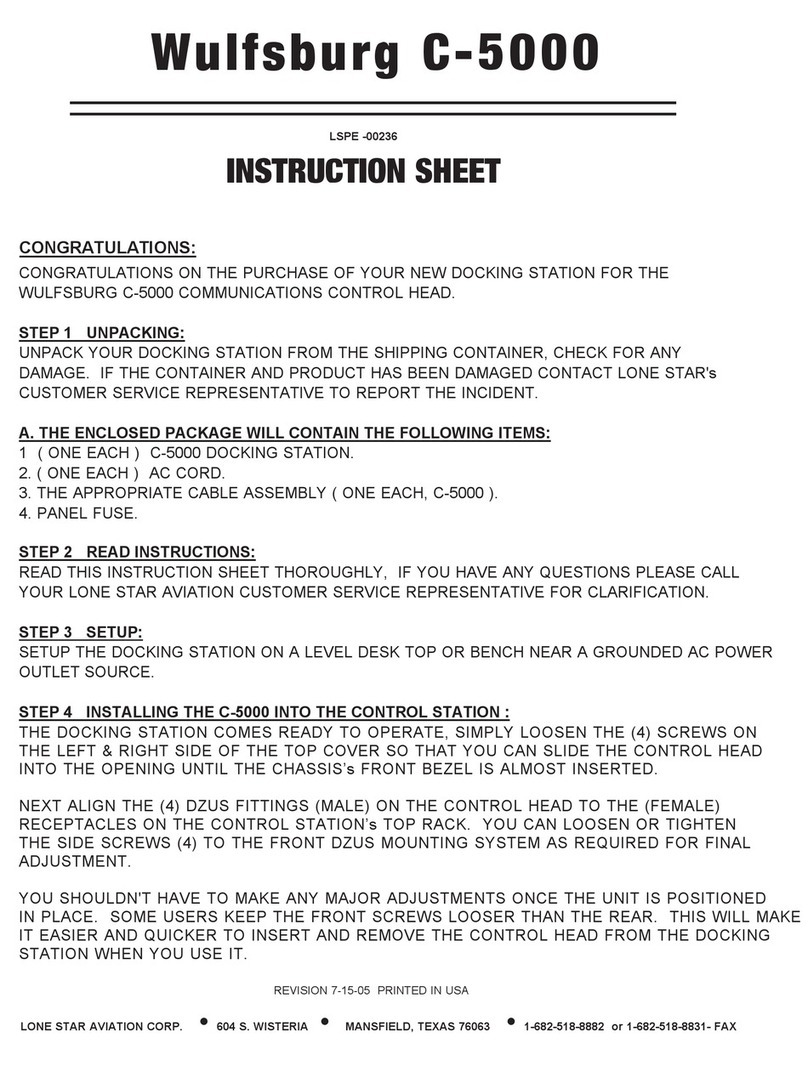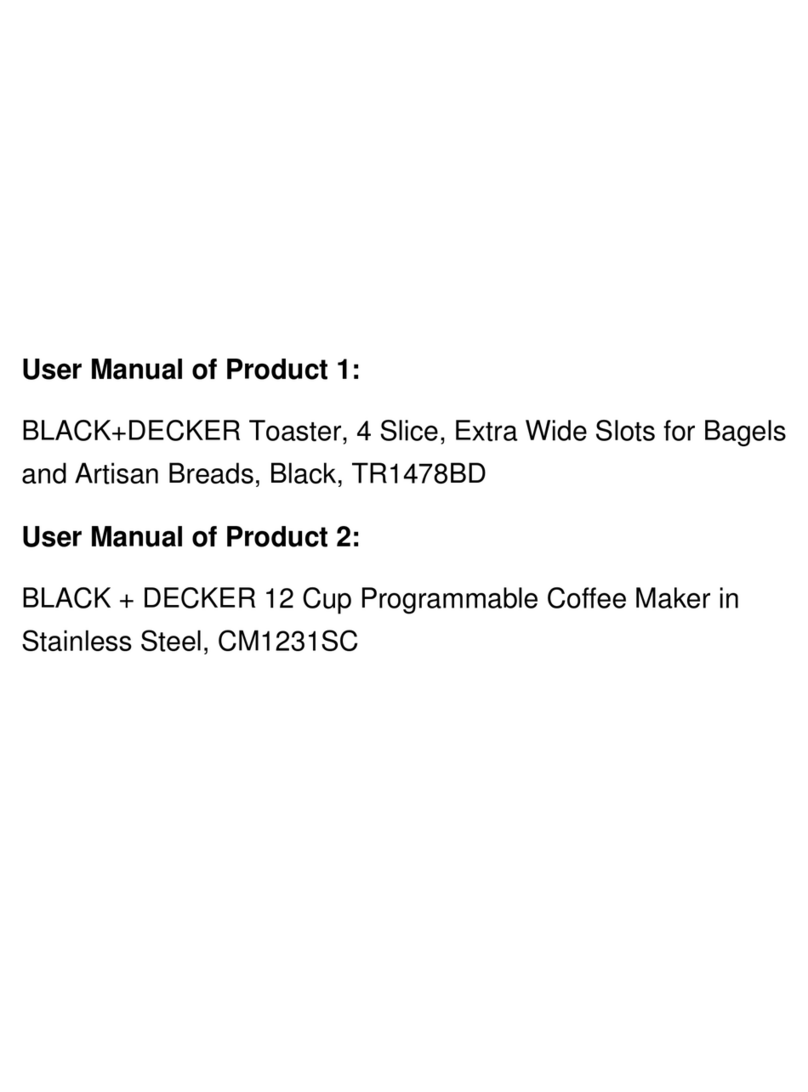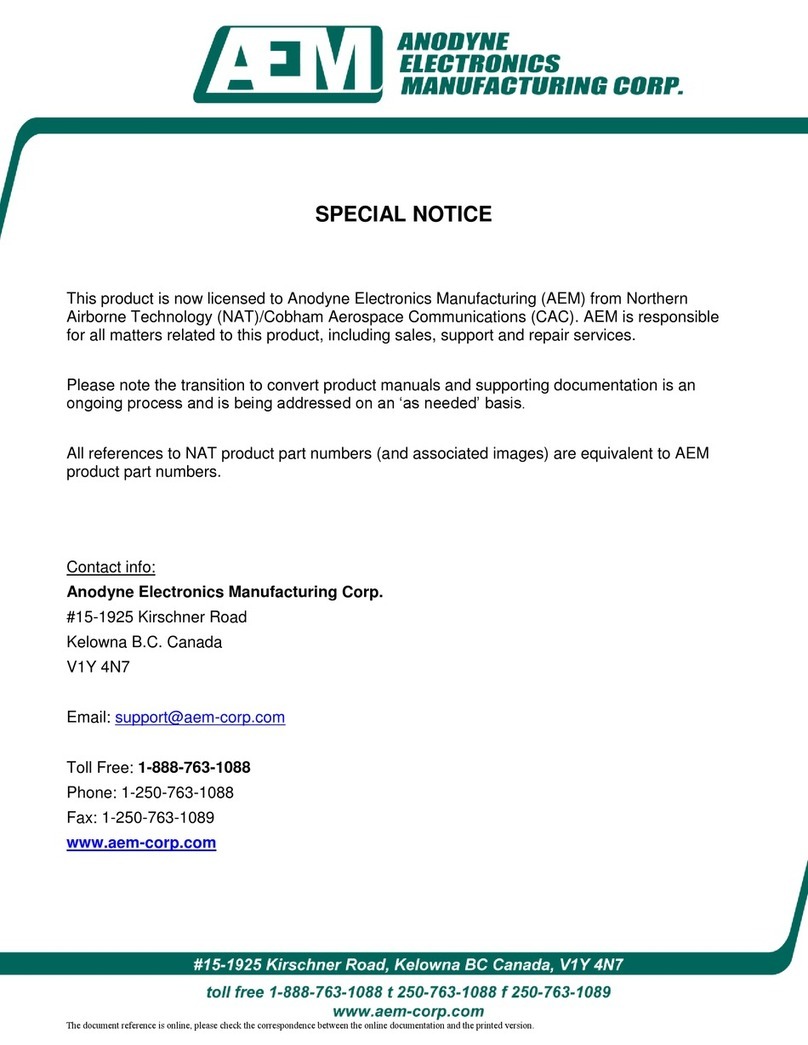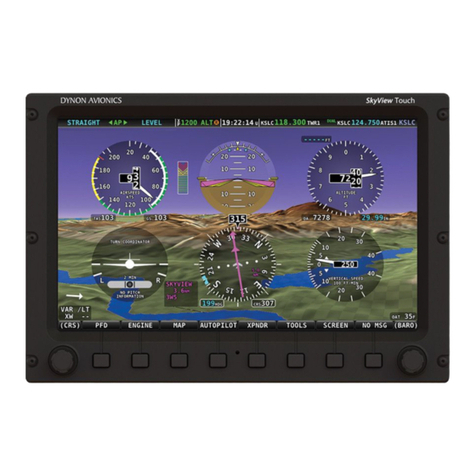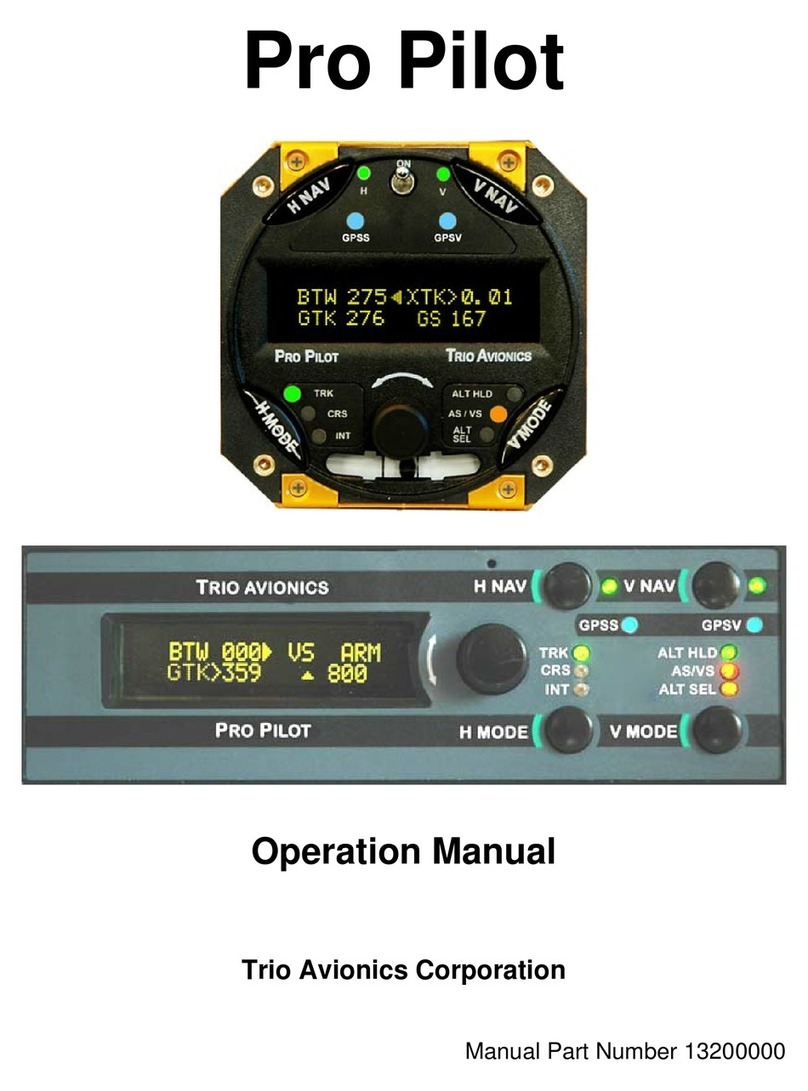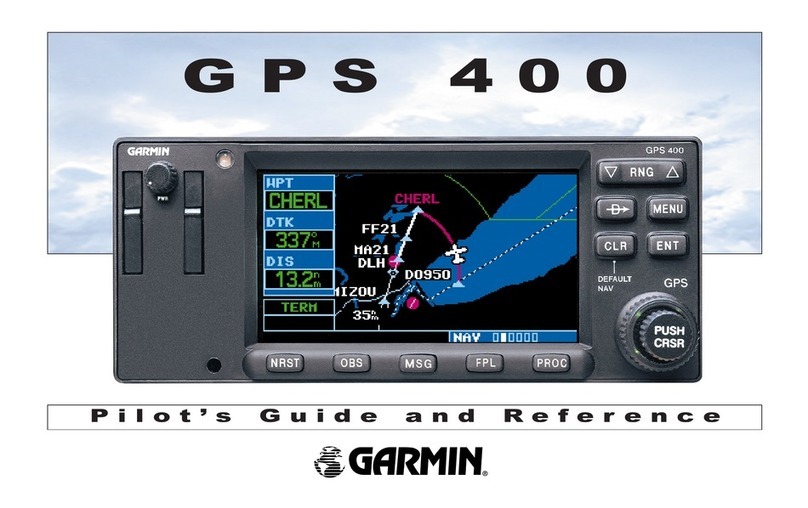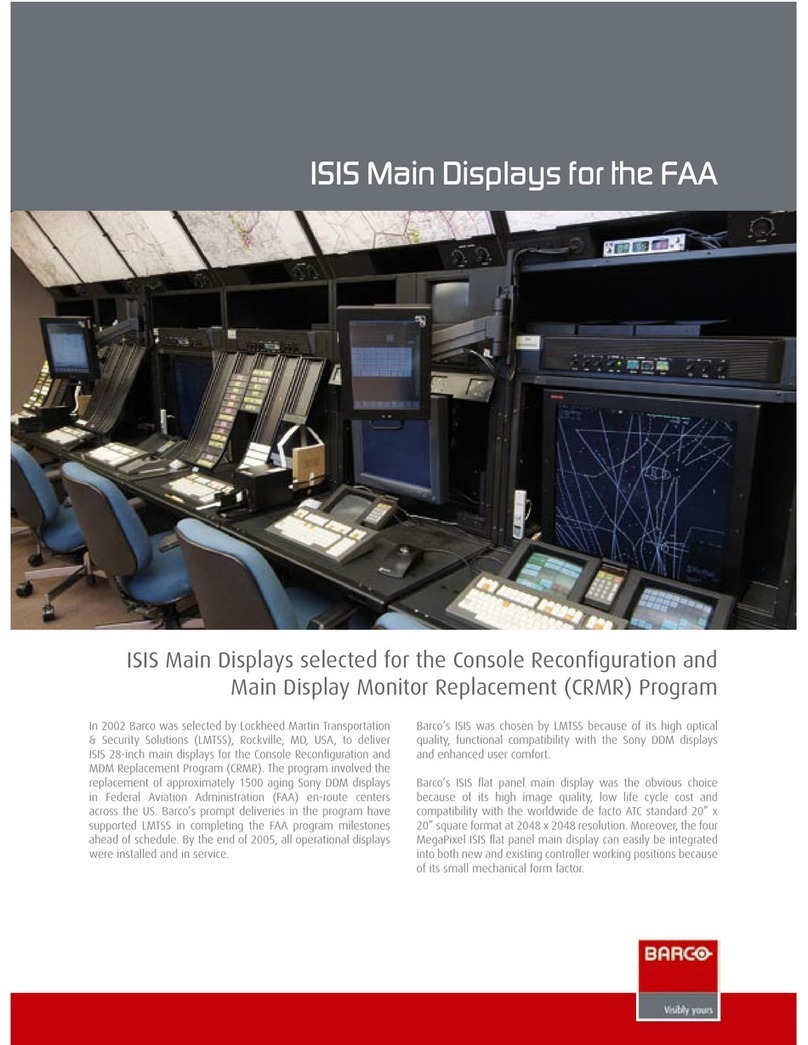BENDIXKing Skymap IIIC Manual

Pilots
GuL
3
KFC
250
BendixlKing
Flight
Control
System
APPR
CPLD
GCCPLD
BAfH
CRS

Table
of
Contents
IntroductiontotheKFC250 FlightControlSystem
.................
3
KFC
250
SystemIntegration 4.5
KFC
250
FlightControlSystemSpecifications
.......................
6
Modesof Operation
.............................................
7
KFC250SystemPanelChecklist 9
Operatingthe KFC250System
......................................
11
SystemSafety-Integrity Monitors
............
12
PreflightTest
.....
...................................
13
FlightDirectorMode(FD)
...................................
14
Autopilot Engagement(AP)
......................................
14
HeadingSelect/PreselectMode(HDG
SEL)
.............................
15
YawDampMode
..............................................
15
NavigationMode(NAVIARMandNAVICPLD)
...........................
16
Approach Mode(NAVIARMandAPPRICPLD.GSICPLD)
...................
17
BackCourseMode(BC)
.........................................
18
Go-AroundMode
.......................................
18
AltitudeSelect Mode(ALTARM)
....................................
18
AltitudeHoldMode(ALT HOLD)
..................................
19
ControlWheelSteeringMode(CWS)
..................................
19
..............................
...............................
...............
uperatingProcedures:
TakeoffandClimbtoSelectedAltitude
...........................
.20.21
Outboundon FrontCourse for ProcedureTurn
toILSapproach
.......................................
.22.23
Front Course ILSApproach with Missed
ApproachandGo-Around
.........................................
24.25
RNAVCapture
.................................................
26.27
2

Introductionto the KFC
250
Flight Control System
complete 3-axis integrated system with laige, 4-inch
tric (or 3-inchvacuumlelectric) Flight Command
Pictorial Navigation Indicators.
An all solid-stateFlight Computer providescom-
d Flight Director commands alongwith complete
is Autopilot control.The system providesall stan-
operating modesplusaltitudepreselectcapability.
This system is designed specificallyto bring the
ntages
of
advanced technology to single pilot
IMPORTANTThisPilot’sGuideprovidesageneral description
of
thevarious
operationalcharacteristics
of
the KFC
250
Flight ControlSystem. However,
operationof thesystemshouldnotbeattemptedwithoutfirstreviewingyour
FAA approved Aircraft Flight Supplement Manual for complete system
familiarizationand limitations.
3

Control System Components
(4
InchInstruments:
SENSE CONTROL COMPUTE DISPLAY
AIP
DiscITrim
Manual
Electric
Interrupt
Switch
CWS Switch
Control Wheel
Switches
Throttle
Go-Around
I
9
II
KPI
552
r?
KEA 346
Servoed
Altimeter
ta
KAS
297
AH
Pre-Select
Monitor
1 1
I
Switch
Pitch
Yaw
Roll
Pitch
Trim
KA
518
KMT
112
ServolMount
ServolMount ServolMount ServolMount
KFC
250
System Integration
The system diagrams show the compo-
nentsof the KFC250 IntegratedFlightControl
System and their relationships.
The systemisfunctionallydividedintofour
parts: Sense, control, compute and display.
All sensor information(pitchand roll reference:
slaved compass: RNAVIVORILOCIGS;
DME:
marker receiver:and air data) is fed into the
KCP 299 FlightComputer.
The FlightComputercomputespitchand
roll steering commands. These
two
com-
mands are routed to the KCI
310
or KI 256
Flight Command Indicator where they are
displayedon theV-bar as visual steeringcom-
mands. These steering commands are also
fed
to
the Autopilot computationcircuits con-
tainedin the FlightComputerwhere the steering
commandsand aircraft yaw rate information
I..
F.
-...:
*
.
._
?
I.
,-.
,
...
.
..
I.
I'
'A
;
,
*'
.

(3
Inch Instruments)
SENSE
CONTROL COMPUTE
KC
2901291
1
KCP299
DISPLAY
KEA
346
Servoed
Altimeter
Annunciator
E
..
Staticlpitot
Pressure
17
KRG
331
AIP
DisclTrim
Interrupt
Switch
Control
Wheel
Switches
KI
256
Flight
Command
1
1
I
I
1
Indicator
KI
525A
Pictorial
Navigation
Indicator
KAS 297
Alt
Pre-Select
grid
Switch
bib
Pitch
Yaw
Roll
Pitch
Trim
ServolMount
ServolMount ServoiMount ServolMount
KA5lB
KMT112
arecombined
to
generatetheaileron,elevator displayedon the V-bar in the FCI, into the re-
trim, and. rudder drive commands for the quiredelevatorandaileron positioncommands.
Autopilot. Full integration of Flight Director and
Usingthesame pitchandrollcommands Autopilot allows the pilot to delegate the
provides totally consistent Flight Director manual effort of flying the aircraft to the
steering command and Autopilot control. Autopilot while monitoring its activity with the
There isno disagreementincomputation.The Flight Director.
Autopilot simply converts the pitch and roll
steeringcommandsfromthe Flight Computer,
5

KING KFC
250
FlightControlSystemSpecifications
Weight
KFC
250
Current Drain
(W
(Kgs)
(Common components)
KC 290 Mode Controller
KC 291 Yaw Controller
KCP 299 Flight Computer
KDC 298 Air Data
KA
136 Trim Monitor
KS 27X (4) ServolMount
KRG 331 Yaw Rate Sensor
KAS
297 AltitudeSelector
KEA 346 ServoedAltimeter
.50 .22
.10 .04
5.90 2.67
1.70
.77
.50 .22
13.40 6.07
.76
.34
1.20 .54
2.90 1.31
10.45 A 28 VDC
4.5 VA26VAC 26.96 12.18
4-Inch
KCI 310 Flight Command
KPI 552 PictorialNavigation
KAP 315 ModeAnnunciator
KVG 350 VerticalGyro
KCS 305 Slaved D.G.
Indicator
Indicator
Total 4-Inch
5.00
2.27
4.80 2.18
1.40 .63
6.00 2.72
5.60 2.54
11.95A 28 VDC
43.6 VA 26 VAC
95 VA max 115 VAC 49.76 22.52
3-Inch
KI 256 Flight Command 3.30 1.50
KI 525A PictorialNavigation 4.00 1.82
KA
285 ModeAnnunciator .50 .20
KG 102AI Slaved D.G. 5.50 2.50
KMT 112/ System
KA
518
Indicator
Indicator
13.85A 28 VDC
Total 3-Inch 4.5 VA 26VAC 40.26 18.20

Flight Director System Modes
of
Operation
Heading
(HDG)
Altitude
Hold
(ALT)
Flight Director
(FD)
FD/AP
-
VerticalTrim
(Pitch Attitude/
Altitude)
-Yaw Dampei
Engagel
Disengage
Navigate (NAV) REV LOC (BC) Approach (APPR)
(VORIRNAV) (ILS. VOR
or
RNAV) ‘Annunciator
Light
FlightDirectorGuidance
and CommandtoAutopilot
BasicAttitude Reference Mode Activated with “power on” but with no
modes selected. The Flight Command
indicator and PictorialNAV indicatorwill
display existing attitude and heading.
The Command V-bar is retracted out of
view until a Flight Director/Autopilot
mode has been selected.
Flight Director(FD) Command V-bar will call for wings level.
The pitch attitude of the aircraft will
remainthe same as at the time
of
mode
selection.
Selectdesiredheadingon PNI,then select
the HDG mode and the system will com-
mand the necessary bank to turn to and
maintainthe selected heading.
Set desired course on PNI and select
NAV mode. The system’s all-angle NAV
Course Capture feature gives the pilot
completefreedomto selectany intercept
angle in responseto ATC vectors, using
HDG mode. The NAV mode
will
be
“armed,” and at the capture point HDG
willautomaticallydisconnectandthe
sys-
tem will “couple” and command the
necessary bank to capture and track a
selected VOR or RNAV course without
overshooting.
Heading(HDG)
NAV (VOR/RNAV)
7

Approach (APPR)
(ILS
or VOR) Set the inbound front approach course
on the PNI and select Approach mode.
The system'sall-angleApproach Course
Capture feature allows the pilot
to
select
any intercept angle in response
to
ATC
vectors, as in the NAV mode. The Ap-
proachmodewill be "armed," and at the
appropriate capture pointthe systemwill
couple" and command the necessary
bankand pitch
to
capture andtrack LOC
and Glideslope beams for precision ap-
proaches..
.
or bank command
to
cap-
ture and track
VOR
courses for non-
precision approaches.
With back course selected in Approach
mode, the system when capturing will
commandthe banknecessary
to
capture
and track a reverse LOC course
. . .
Glideslope is locked out. The inbound
front approach course is always set on
the PNI
to
enable you to make course
corrections toward theneedle ratherthan
away from the needleon the PNI.
Push the
"Go
Around" button and the
system will command wings level and
nose up
to
a preset missed approach
climb attitude.
Pitch command
to
maintain engaged
altitude.
Provides capability
to
adjust or slew the
Altitude upor down without disengaging
and then reengaging ALT Hold. If Alti-
tude Hold is not engaged, the Vertical
Trim knobwill adjust the pitch attitude
UF
or down.
Permitspreselection of a desired altitude
and automatic capture upon reaching
that altitude.
Control surfaces respond
to
all selected
Flight Director mode commands in both
pitch and roll axis plus automatic pitch
trim. A full time yaw damper is in opera-
tion any time the Autopilot is engaged.
Separate Autopilot servos and capstans
make it easy
to
remove and service the
control surface servoswithout de-rigging
the surface control cables.
Allows manual flight maneuvering with-
outthe need
to
disengage and reengagc
the Autopilot. With the CWS switch de
pressed, the system pitch axis is syn
chronizedwith the airplaneandthe Auto-
pilot servos disengage,
so
the pilot can
handfly the airplane(intheexisting mode
with Autopilot engaged) without remov-
ing his hand from the control wheel.
System senses motion around the yaw
axis and automatically movesthe rudder
to
opposeyaw.
Back Course (BC)
Go Around (GA)
Altitude
Hold
(ALT)
Vertical Trim
Altitude Preselect
Autopilot (AP)
Control Wheel Steering
Yaw Damp Engage
8

KFC
250
System
Panel
Checklist:
1.
THE KAP
315
ANNUNCIATOR PANEL
providesthe pilot with continuous information
on systemoperating status.
It
shows modes
in operation,as well as modes “armed”
prior
to
capture.
It
also displays Marker
Beacon lights and a Trim Fault warning.
2.
THE KPI
552
PICTORIALNAVIGATION
INDICATOR
displaysslavedgyro magnetic
heading information.By positioningthe
“Heading Bug” on the PNI with the ”heading
select” knob, the pilot selects the desired
aircraft heading.For VORlLOClRNAV course
selection,the “course select” knob is used.
Glideslope deviation is shown on the left side
of the instrumentface when a valid Glideslope
signal is received.TOlFROM indicationsand
appropriatewarning flags are also displayed
on
this indicator.
A KPI 553A PNI with built in DME display
and
RMI
pointer is availableas an option
(see picture on page
11).
3.
THE KCI
310
FLIGHT COMMAND
INDICATOR
displaysthe following
information:
Pitchand roll attitude
Pitch and rollcommands
DecisionHeight
(DH)
RNAV Annunciation(RNV)
SkidlSlip on inclinometer
Separate wiring from the remotevertical
gyro
to
the attitude indicator and strict
separationof attitude and commandbar
power circuits assure the pilot
of
attitude
referenceeven in the event of a Flight
Computer failure.
4.
THE KC
290
MODECONTROLLER
providespushbuttonselection of all Flight
DirectorlAutopilotmodes,plusVerticalTrim.
This trim switch allowsthe pilot
to
adjust the
aircraft’s altitude or pitch attitude without
disturbingthe selected Flight Director mode
or disengaging the Autopilot.The Autopilot
engage switch engages all three axis of the
Autopilot.The compact
KC
290
unit can be
easily installedin panelor pedestal mount
configurations.
9

1A. THE
KA
285 ANNUNCIATOR PANEL
providesthe same functions as the KAP 315
with the exception of the
ALT
ARM light.
I
2A.
THE KI
256
3-INCHVACUUMlELECTRlC
FLIGHTCOMMAND INDICATORdisdavs
.~
the following information:
Pitch and rollattitude
Pitch and rollcommands
Decisionheight (DH)
3A. THE KI 525A PICTORIALNAVIGATION
INDICATORdisplaysslavedgyro magnetic
heading informationand operates similarly
to the KPI 552.
6.
KEA
346
SERVOED ALTIMETER provides
barometriccorrected altitude informationto
the KAS 297 Altitude Selector and encoding
for an ATC transponder.
5.
THE OPTIONAL KC
291
YAW MODE
CONTROLLERcan be installed alongside
the KC 290 Mode Controller. In this config-
uration the yaw axis is wired
so
that it
automaticallyengages when the Autopilot is
engaged. Disengagement of the yaw damper
is accomplishedby usingthe control wheel
mounteddisengageswitch or the KC 291
engageldjsengageswitch.
The Yaw Damperonly is engaged
or disengagedusing the KC 291. The Yaw
Damper engage status is annunciatedon
7.
THE
KAS
297
ALTITUDE SELECTOR
the KC 291. permitsthe pilot to preselect a desiredaltitude
Some airplanesare certified with the in climb or descent. The system provides
yaw damper on at all times when the autopilot automatic capture and hold upon reaching
is
engaged. (Refer
to
Flight Manual Supple- that altitude. Altitudealerting is also provided
ment to determine your type of installation.) as requiredby FAR 91.51.
A
L'
IRH
SELECTED ALTITUDE
v
SET
A
"..An
10

r
i
Operatingthe
KFC
250
System
Therearetwelve
(12)
modesof operation
that are providedby the KFC
250
systemto
offer the pilot Flight Director/Autopilotcom-
mandsinresponsetohisselectionof desired
modes
on
the ModeController.
Most of these modes are activated by
pushbuttonswitchesontheModeCorltroller.
These pushbuttons operate with alternate
action.Thefirst depressionofthepushbutton
activates a mode; the second depression
cancelsit,
if
it hasnotalreadybeenautomat-
ically inactivated.Annunciationof the mode
selectedappears on the annunciatorpanel.
Anyoperatingmodenotcompatiblewith
a newly-selectedmodewill beautomatically
cancelled in favor of the pilot’s latest selec-
tion. This lets the pilot advance along his
flightsequencewithout theinconvenienceof
having to manually cancel modes. For
example, if in NAV CPLD mode,selectionof
Headingwill automaticallycancel NAV.
THE BASIC MODE
OF
SYSTEM OPERATION
The system will be in the Basic Attitude
Referenceor “Gyro” mode with engines run-
ning and aircraft “power on,” but no modes
selected (Annunciator Panel blank). This
provides indication of aircraft headingon the
Pictorial Navigation Indicator, and roll and
pitch attitude on the Flight Command indi-
cator. The FCI Command V-bar is biased out
of
view.
11

System Safety
Is
Assured
By
Integrity Monitors
The KFC250monitorsthe validity of the
system sensors and the Flight Computer
to
alert the pilot when the system cannot res-
pondcorrectly
to
commandsignals
Invalid” signals provide visual warvlng
by meansof the flags and annunciators In-
valid” signals are also routed
to
the KFC 250
switchinglogic
to
“lock out” modeswhichwill
not operate reliably
Most failures in the slaved compass
system would be annunciatedby a compass
flag andthe system would not allow selection
of the Heading,NAV or APPR modes
The illustrationsabove showthe KFC250
Flight Directorcockpit displays with all warn-
ingflags inview
Flight Command indicator warnings:
Flight Director(FD) CommandV-bar will bias
out of view whenever the FD mode is not
selected, and when FD internal power is in-
adequate Attitude and computer flags will
alsobe inview
The Pictorial Navigation Indicator
warnings: A compass flag indicatesthat the
compass cardis not displayingproperheading
A NAV flag indicatesthat a valid NAV Signalis
not being received
12
-
When an ILSchannel is selectedon the
NAV receiverand a valid Glideslope signal is
received, the Glideslope pointer will appear.
Glideslope coupling usually occurs at Outer
Marker, when the Glideslope is intercepted
(glideslope pointers centered) and APPR
CPLD. If, after GS coupling, the GS pointer
disappears, the system will flash the GS An-
nunciator and go from GS coupled
to
Pitch
Attitude Hold.
If
the GS pointer reappears,
the system will revert back
to
GS
coupled.
The NAV warning flag indicates an invalid
Localizer but has no effect on Glideslope
operation.
In the Approach mode, in an aircraft
equippedwith dual
LOC
andGS receivers,Ap-
proachmonitoringis providedif bothsystems
are tuned
to
the LOC frequency.
If
the devia-
tions of No.2
LOC
or GSdiffersgreater thana
preset amount the appropriate annunciator
light(APPR or GS)will flash.
The Trim warning light in the Annun-
ciator Panelwill light when a monitoredAuto
or Manualelectric trim failureoccursor when
the trim breaker is pulled.
It
will also flash
4
to
6
timeswhen theTEST switchon the Mode
Controller isdepressed.

i
1.
PreflightTest Determines, BeforeTakeoff,
that the System is Operating Normally.
With power on, a!l circuit breakers in,
and engine running, allow
3
minutesfor the
gyros
to
come up
to
speed.
Make sureyou are in slaved gyro mode
by confirmingthe statuson the
KA
51
B
Slav-
ing Meter and compare the compasscard on
the KPI 552 or KI 525A with your magnetic
compass.
With no modes engaged, depress the
Preflight Test button on the Mode Controller.
All modes will be annunciatedon the Annun-
ciatorPanel,includingthe3 Marker lights, and
the redAutotrim lightwillflash.At leastfour and
not morethan six flashes mustbebeobserved
to
indicate proper operation of the Autotrim
monitor f.eature. The KCI 310 computer flag
will also come intoview. (Figure1)
For attitude indicatortest, push the test
buttonon the KCI
310
front panel.Theattitude
and compass flags will appear and the pic-
torial horizonwill display a climbingright turn.
(Figure2)
The KI256 FCIdoes nothave a computer
or attitudeflagor attitudetestsincethegyrois
air driven.
The pilot first engagesthe Flight Director
to
activate the Command V-bar. Then he
engages the Autopilot. The Autopilot will not
engage when the Flight Director is not
operating.
Now depress the CWS switch, center the
display on the Flight Command Indicatorand
release the CWS switch. Then apply force
to
the controls
to
determine if the Autopilot can
be overpowered.
CAUTION:
Operation of the Autopilot on the
groundmay causethe autotrim
to
runbecause
of back force generated by elevator down-
springs
or
pilot inducedforces.
Some aircraft havepreflighttest sequen-
ces required in addition
to
the general pro-
ceduresdescribedhere.See the
FAA
approved
Aircraft Flight Manual Supplement for
your
particular aircraft for details.
IMPORTANT:
This pilot Guide provides a
general descriptionof the various operational
characteristicsof the KFC 250 Flight Control
System.
However, operationof the system
should not be attempted without first
reviewing
your
FAA
Approved Aircraft
Flight Supplement Manual for complete
system familiarizationand limitation.
13

FLIGHTDIRECTOR Mode(FD)
The Flight Director mode
is
activatedby
depressing the “FD” button on the Mode
I
Controller.
The FCI Command V-bar will appear
and providethe pilotwith steeringcommands
to
maintainwings level and the pitch attitude
that existed at the time of Flight Director
engagement.
If pitch or roll attitude are changed, re-
cycling the FD button will synchronize the
CommandV-bar
to
the newsituation.
If
achangeonly inthe commandedpitch
attitude isdesired,theControlWheel Steering
(CWS) button installed on the pilot’s control
wheel allows the pilot
to
synchronizetheCom-
mand V-bar (in the FD mode with Autopilot
disengaged)without removing his hand from
thecontrolwheel.
The Flight Directorcanalso beactivated
by direct selection of any specific mode,
which will activatethe Command V-bar.Such
selection will annunciate both FD and the
appropriatemode.
The Vertical Trim switch on the Mode
Controller may also be used
to
adjust the
selected pitch attitude up or down at approx.
1
degreelsecond.
Special note: The FD mode must be
activated before the Autopilot can be
engaged.
AUTOPILOT Engagement
TheAUTOPILOT is engaged by moving
the solenoid-held AP toggle switch on the
ModeController
to
theONposition. Notethat
theAP andtheYAW DAMP(YD)switchesare
wired
so
that the YAW DAMP mode is
automaticallyengaged with the AP switch.
The Autopilot, together with the Yaw
Damper, provides three-axis stabilization,
automatic turn coordination and automatic
elevator trim as well as automatic response
to
all selected Flight Director commands.
I
CAUTION:
When the autopilot is engaged,
manualapplication of aforce
to
the pitchaxis
of thecontrolwheelfor aperiodof
3
seconds
or
more will result in the autotrim system
operating in the direction to create a force
opposing the pilot. This opposing mistrim
forcewill continue
to
increaseas long as the
pilot applies a force
to
thecontrol wheel and
will ultimatelyoverpower the autopilot.
If
the
I
If
I
autopilot is disenoaoed under these
conditions, the p
lot
mayberequired to exert
control forces in excess of
50
pounds to
maintain the desired aircraft attitude The
Dilot wi,Ihave
to
maintain
tnis control force
while he manually retrimsthe aircraft
CAUTION:
Prior to Autopilot engagement,
the pilot should make sure the V-bar com-
mands are satisfied This
will
prevent any
rapid changes in the aircraft’s flight path
when the Autopilot
IS
engaged
14

HEADING SELECT/PRESELECT
Mode
(HDG SEL)
Selecta desiredheading by positioning
the heading "bug" on the PNI. This is done
with the HDG knob onthe PNI.
Depress the HDG button on the Mode
Controller
to
activate the HDG
SEL
mode.
HDG
SEL"
willlightontheAnnunciator Panel
and a computed, visually displayed bank
command isshownonthe FCI.Followingthis
bankcommand,theaircraftwillbankandroll
out
onthe desired preselected heading.
The CommandV-bar on the FCI will de-
flect in the direction
of
the shortest turn
to
satisfy the commanded turn
to
the pre-
selected heading. The aircraft may be man-
ually banked
to
realignthe V-bar and satisfy
the commandor, if theAutopilot isengaged,
the aircraft will automatically bank, turn
to,
roll
out
andholdthe preselected heading.As
the aircraft approaches the selected head-
ingthe V-bar willcommand a rollout
to
wings
level.
With the HDG
SEL
mode in operation,
subsequent changes made in the heading
bug" position on the PNI will immediately
causetheV-bar onthe FCI
to
call for aturnto
the new heading.
The HDG
SEL
mode is cancelledwhen
NAV or APPR coupling occurs,or whenever
the FDor HDGmode buttonsaredepressed.
CAUTION:
An invalidheadingsource (com-
pass flag in view) will automatically disen-
gagetheautopilot.Theautopilot maythenbe
re-engaged, however, only the vertical
modeswill beuseable.
YAW DAMP Mode
The KC 291 Yaw Mode Controller is in-
stalled beside the KC 290 Mode Controller
andthe yaw axis iswired
so
that it automati-
cally engages when the Autopilot
IS
en-
gaged Disengagement
of
the Yaw Damper
is accomplished by using the alternate ac-
tion switch (pushbutton) on the KC 291 The
Yaw Damper may beengaged alonewith
or
without any Flight Director mode
It
usually
provides a more stable aircraft whether
control surfacesare operated manuallyor by
the Autopilot The Yaw Damper engage
status is annunciated on the KC 291 Yaw
ModeController
15

NAVIGATION(NAV ARM
and
NAV
CPLD)
Mode
The NAV mode provides visual bank
commands onthe FlightCommand Indicator
and deviation guidance on the PNI
to
inter-
cept and track a VOR course or an RNAV
course.
Operation of the NAV mode requiresthe
pilot
to:
1.
Tune the frequency of the selected VOR
(or VORTAC) station.For RNAV operation,
set inwaypoint distance and bearing from
the VORTAC station.
2.
Set the PNI course pointer on the de-
sired course.
3.
Establish angle of intercept by setting
heading"bug"and activate "HDG" mode.
4.
Depress the NAV button on the Mode
Controller.
When the "NAV" button on the Mode
Controller is depressed, "NAVIARM" will be
lighted on the Annunciator Panel and the
automatic capture circuit is armed. Heading
select, if operating, is retained until capture
occurs.
The VOR or RNAV "course-capture''
point is variable
to
prevent overshoot and
depends on angle of intercept and the rate
the course deviation ischanging.Uponcap-
ture, a bank command will bedisplayed on
the FCI;the HDG,if on,will becancelledand
"NAVICPLD"will be lighted on the Annun-
ciator Panel.
The pilot canmanuallybank the aircraft
to
satisfythecommanddisplaywhichwillcall
for a rollout
to
level flight when on course
centerlhne
to
track the course. Crosswind
compensation is provided in the "track
state.
If
the NAV mode is selected with the
aircraft level within
k4'
of bank and within
three dots of coursedeviation, NAVIARMwill
be bypassed and NAVICPLD will engage
directly.
If the Autopilot
is
engaged, the aircraft
willbank
to
satisfythe command display and
rollout on course automatically.
Uponstation (orwaypoint) passage, an
outbound course other than the inboundre-
ciprocal can be selected by resetting the
NAV course arrowon the PNI.This willcause
an immediate V-bar deflection on the FCIdi-
rectinga turn
to
the,newcourse.
The NAV modeis cancelled bydepress-
ingthe NAV button, or selecting HDG (when
in NAVcoupled)or APPR modes,or pushing
FD
to
"OFF'.
CAUTION:
The NAV mode of operation will
continue
to
provideairplanecontrolwithouta
valid VOR/LOC signal (NAV flag inview).
1
I
16

APPROACH (APPRIARM, APPRICPLD
and
GS
CPLD)
Mode
TheAPPR modeprovidesvisual rolland
pitchcommandsonthe FCIV-bar
to
capture
and track precision ILS (LOC and Glide-
slope) beams,or non-precisionVOR radials
Lateral and vertical deviation can be moni-
tored onthe PNI
Operation of the APPR mode requires
the pilot
to
1.
Set the NAV receiverfrequency
2.
Set the PNI course pointer
to
the in-
boundrunwayheading or.the front course
incaseof ILSprecision approach Dothis
even on back course approach
3.
SettheHDGSEL"bug"onthe PNI
to
the
desired intercept angle and activate
HDG" mode
4.
Depressthe"APPR"buttononthe mode
controller
The automatic APPR capture function
will beimmediatelyarmed "APPR/ARM"will
be
11
hted on the Mode Annunciator Panel
fn APPR/ARM mode, prior
to
capture,
the headingselect modeisretained inorder
to
allow the pilot
to
adjust heading
to
Approach Controlvectoring instructions
The LOC beam or VOR "capture" point
will vary, depending on angle of intercept
and rate of change of deviation indication
Upon capture, a bank command will be in-
troduced on the FCI, the existing heading
mode will be cancelled and "APPRICPLD"
will be lighted onthe Annunciator Panel
The pilot maymanually bankthe aircraft
to
satisfy the command display, which will
command a rollout
to
level flight when the
aircraft is on course Automatic crosswind
compensation will provide precise tracking
VOR/LOCdeviationisshownonthePNI,and
actual crab angle will be shown by offset
of
the course arrow fromthe lubber line
ThroughoutAPPR modeoperation, LOC
and Glideslope deviation or VOR deviation
are displayed in the PNI
IftheAutopilotisengagedduringopera-
tion in the APPR mode, automatic steering
responsewillfollowthe commanddisplay on
the FCI
The Glideslope mode is armed for au-
hasoccurred AutomaticGlideslope capture
occurs as the aircraft passes through the
glide pathfrom aboveor below
Upon interception of the Glideslope,
capture occursand "GS CPLD"is lighted on
the Annunciator Panel A smooth capture
pitch command is displayed by the Com-
mand V-bar The pilot (or Autopilot) controls
the aircraft
to
satisfy the Command V-bar
Upon
GS
capture, the ALT HOLD mode
(if active) is cancelled. However, ALT HOLD
may be manually reselected
to
maintain
altitudeuponreachingMDA if visual contactis
not
established
t
tomatic capture
if
LOCfront course capture
L
P
During VOR or RNAV approaches,
Glideslope capture will not occur because
the NAV receiver ischanneled
to
a VOR sta-
tion, not an ILS, and this locks out the Glide-
slope function.
APPR/CPLD mode is cancelled by
selectionof HDG,NAV, or Go-Around modes
.
. .
or pushing FDor APPR
to
"Off".
CAUTION:
TheAPPR mode of operationwill
continue
to
provideairplanecontrol withouta
valid VOR/LOC signal (NAV flag in view).
17

BACK COURSE (BACK CRS)
Mode
Whenever a
LOC
or
ILS
frequency is
selected, the BC mode may be activated by
depressing the BC button on the Mode Con-
troller,
after
selecting APPR. When in BC
mode and Localizer caDture occurs. the
I
system will turn and track outbound on the
front course or inbound on the back course.
The BC mode reverses the
LOC
deviation
signal and course datum
to
permit the FCI
steeringcommanddisplay
to
operateon afly-
to
rather than a fly-from basis on the reverse
course. “BACK CRS” is lightedon the Annun-
ciator Panel.
Operation on BC is identical to front
course operation including setting the PNI
Course Pointer
to
the front course heading,
except that automatic Glideslope capture is
“locked out” by the switching circuitry.
Localizerdeviationon PNIwill havethe proper
sensing if the front inbound Localizer course
was set on the PNI.
GO-AROUND
Mode
The Go-Around mode is primarily de-
signed
to
assist the pilot in establishing the
properpitchattitudeundermissedapproach
conditions.The Go-Aroundswitch is located
on the throttle lever for pilot convenience
when applyingclimb-out power.
Depression of the Go-Around switch
during an approach cancels all Flight Di-
rector modesanddisengages the Autopilot,
if it is engaged.*A wings-leveland pitch-up
command is displayed by the
FCI
and
:GO
AROUND” is lighted on the Annunciator
Panel. The magnitudeof the pitch-up com-
mand is adjustable
to
match Flight Manual
criteriafor each aircraft model.
The Go-Aroundmodemay also beused
on takeoff for climb-out attitude guidance.
When usedfor takeoff, the Go-Aroundmode
may be followed with HDG for continuous
heading control during departure. NAV and
APPR modesmayalso bearmedfor automa-
tic capture and guidance during the depar-
turesequence.
Go-Aroundmay be cancelled by use of
Vertical Trim, Altitude Hold mode, Control
Wheel Steering mode or by turning off the
FlightDirector.
*Some airplanes are certifiedwith the Auto-
pilot remaining engaged when GA is
selected. (Refer
to
Flight Manual Sup,ple-
mentto determineyour type of installation.)
ALTITUDESELECT (ALT ARM)
Mode
This mode allows the pilot to select an
altitude and, upon approaching that se-
lected altitude, obtain an automatic visual
pitch command on the FCI
to
capture and
hold the preselectedaltitude.To operate in
this mode the pilot must:
1.
Set the desired altitude into the
“selectedaltitude”window of the KAS
297
Altitude Selector.
18

2.
Establish a climb or descent as appro-
priate.
3.
Depress the ARM button on the Altitude
Selector.This maybedone at any time dur-
ingthe climbor descent beforetheselected
altitude has been attained. “ALT ARM” will
light on the Annunciator Panel and on the
Altitude Selector.
4.
The Altitude “ALERT” annunciator in the
KAS
297
will illuminate(andinmostsystems
atwo second auraltonewill sound)
1,000
ft.
prior
to
reaching selected altitude and will
cancel at
300
ft. prior. An aural tone will
sound upon reachingaltitude.
As the aircraftapproachesthe selected
altitude, an “adaptive”pitch,rate command
will automaticallyguidethe pilotthroughit at
a low rate. As the aircraft reaches the
selected altitude, ALT HOLD,will automati-
cally engage, “ALT HOLD” will light on the
Annunciator Panel and “ALT ARM” will dis-
appear.The command bars on the FCI will
call for levelflight at the selected altitude.
If
autopilotisengaged,thesystemwill perform
the requiredmaneuvers.
ALT ARM is disengaged by depressing
the ALT ARM button, by engaging ALT
HOLD, by GS capture,or selecting FLT DIR
to
OFF.
ALTITUDE HOLD (ALT HOLD)
Mode
This mode will cause a computed visual
pitchcommand
on
the FCI command bars
to
hold the aircraft at the pressure altitude ex-
isting at the time it was activated.
The mode is activated either automati-
cally by the ALT ARM function, or manually
by depressing the ALT button on the Mode
Controller.
If
the autopilot is engaged, it will auto-
matically hold the aircraft at that altitude.
The VerticalTrim switch may be used
to
adjust the selected altitude up or down at a
constant rateof approximately
600
fpm without
disengagingthe mode. This enables the pilot
to
conveniently adjust the aircraft altitude
to
match resetting of the altimeter, or
to
make
short descent segmentsduring a nonprecision
approach.
The ALT HOLD mode is cancelled by
automatic Glideslope capture or selection of
ALT ARM, or GO-AROUNDmodes, or selec-
tion of FLT DIR
to
OFF.
CONTROL WHEEL STEERING
(CWS)
Mode
When the Autopilotis engaged,Control
Wheel Steering provides the pilot with the
capabilityfor natural andconvenientmanual
maneuveringof the aircraftwithout the need
to
disengageand reengagetheAutopilot,or
reselectany modesof operation.
The CWS modeisengagedby continu-
ous pressureonthe CWSbutton,preferably
located on the left-handhornof the control
wheel. Operationof the CWS buttoncauses
immediate releaseof Autopilot servos and
allows the pilot
to
assume manual control,
while Autopilot control functions and Pitch
Command and Altitude Hold modes are
placed in a synchronizationstate.
This meansthat these modes remain in
continuous synchronization with the pilot’s
aircraft maneuvers
so
that, upon release of
the CWS mode button, the Autopilot will
smoothly reassumecontrol of the aircraft
to
the original lateral command and existing
verticalcommand.
Since all engaged modes remain
coupled (in synchronization)during opera-
tion of the CWS mode, their annunciator
lights will continue
to
show on, the Annun-
ciator Panel. The CWS mode is not sepa-
ratelyannunciated.
19

I
1.
The FDhasbeenengaged.Takeoff isinthe
GO-AROUND mode, activated by depres-
sing the GO-AROUND buttonlocatedon the
throttle.“GO-AROUND”is lighted In the an-
nunciator panel. Wings are commanded
level and the nose up
to
the GO-AROUND
angle.Takeoff is on runway
35
as shown on
the PNI.
2.
The aircraft is well off the ground and
climbing.
The heading “bug”on the PNI is turned
to
a desired heading and HDG mode has
been pushedon.
The Flight Director has responded with
the Command V-bar calling for a left turn
to
the
270”
headingand takeoff pitch attitude.
The aircraft has not yet responded
to
the
heading command but will as soon as the
Autopilot is engaged.
Other manuals for Skymap IIIC
7
Table of contents
Other BENDIXKing Avionic Display manuals
Popular Avionic Display manuals by other brands

Aircatglobal
Aircatglobal VirtualFly SOLO AIRLINER-RS user manual
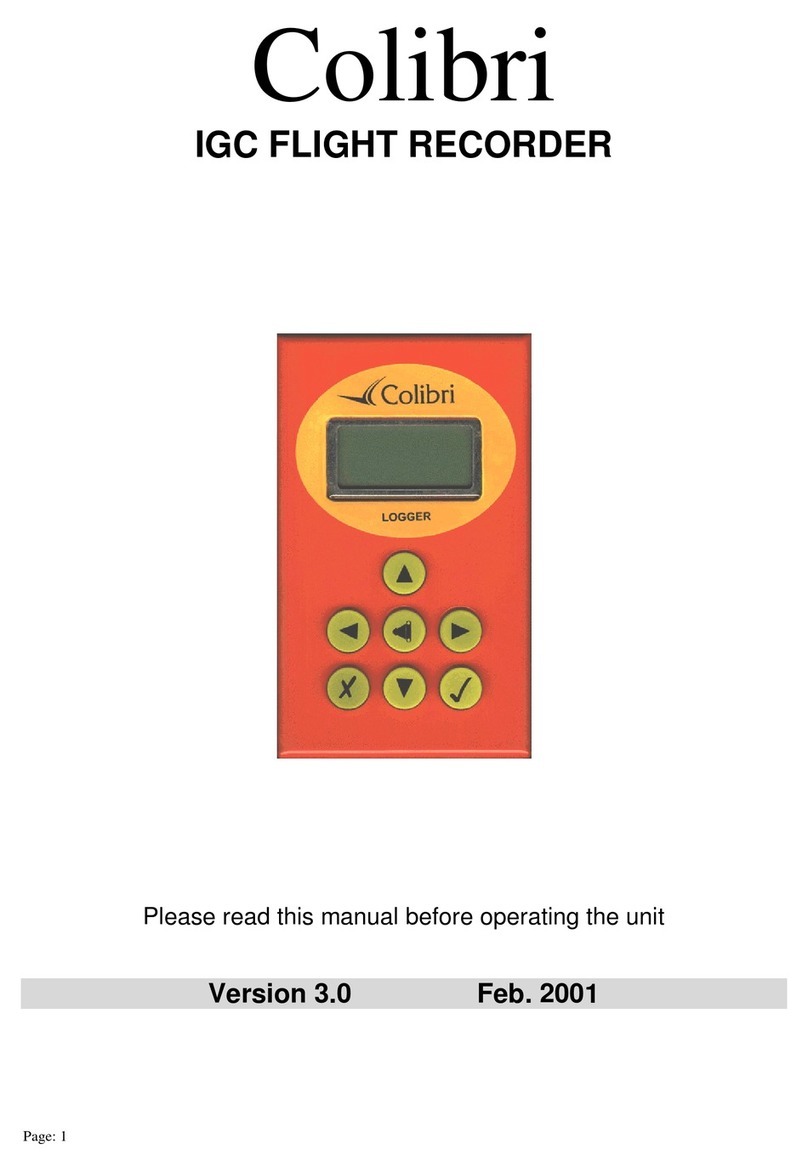
Colibri
Colibri igc flight recorder manual
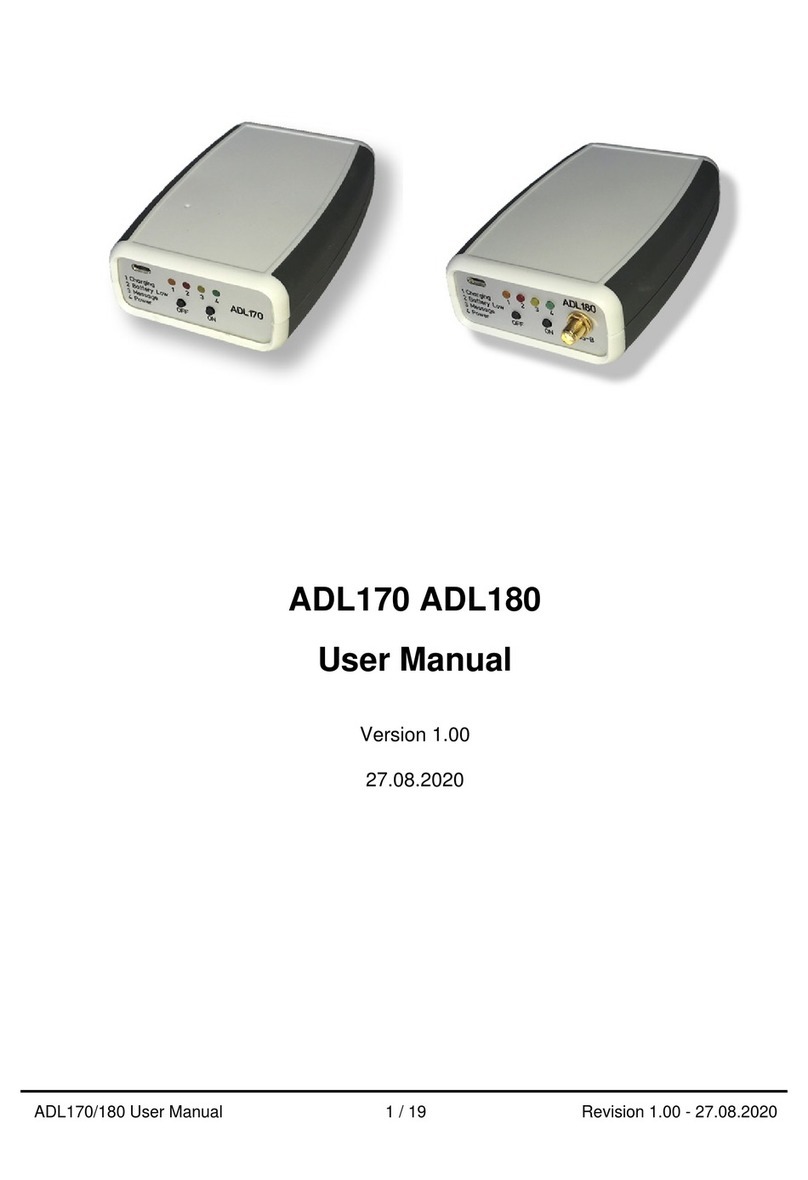
Golze Engineering
Golze Engineering ADL170 user manual

Foxtronics
Foxtronics FOXCART MARK II Operation and service manual
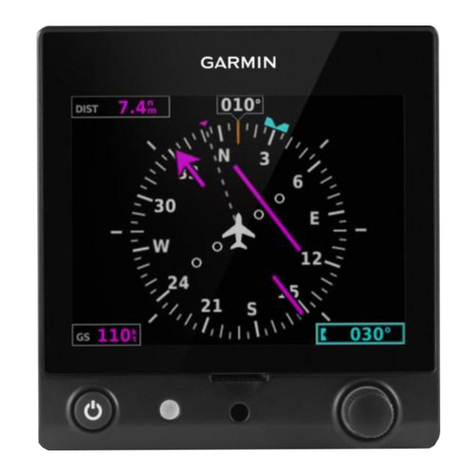
Garmin
Garmin Approach G5 - GPS-Enabled Golf Handheld installation manual
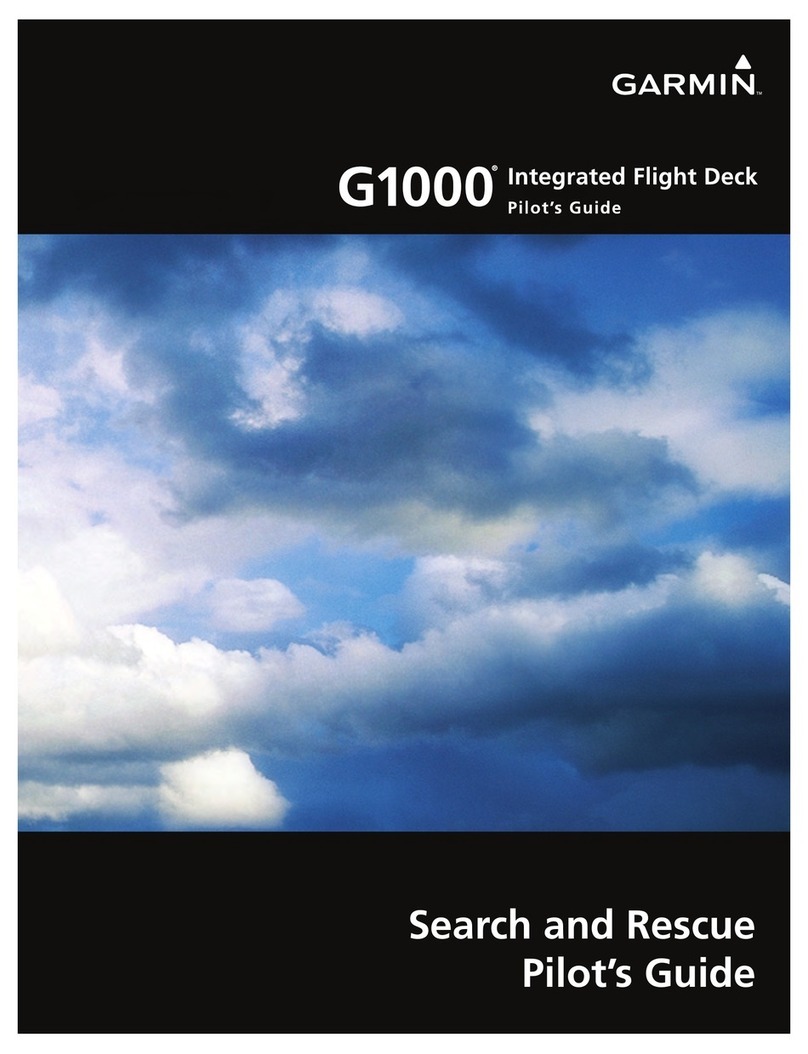
Garmin
Garmin Cessna Caravan G1000 pilot's guide

